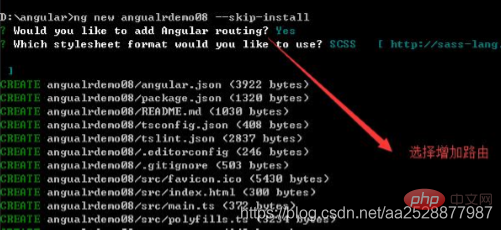詳解Angular中的路由及其用法
- 青灯夜游轉載
- 2021-03-03 10:01:481906瀏覽
本篇文章帶大家來了解Angular中的路由,以及Angular路由的使用。有一定的參考價值,有需要的朋友可以參考一下,希望對大家有幫助。

相關推薦:《angular教學》
一、
1、指令建立專案ng new ng-demo --skip-install
ng g component components/home ng g component components/news ng g component components/newscontent3、找到app-routing.module.ts 設定路由
import { HomeComponent } from './components/home/home.component';
import { NewsComponent } from './components/news/news.component';
import { ProductComponent } from './components/product/product.component';設定路由
const routes: Routes = [
{path: 'home', component: HomeComponent},
{path: 'news', component: NewsComponent},
{path:'product', component:ProductComponent },
{path: '*', redirectTo: '/home', pathMatch: 'full' }
];4、找到app.component .html 根元件模板,設定router-outlet 顯示動態載入的路由
<h1> <a>首页</a> <a>新闻</a> </h1> <router-outlet></router-outlet>
#二、Angular routerLink 跳轉頁面預設路由<a>首页</a>
<a>新闻</a>
//匹配不到路由的时候加载的组件 或者跳转的路由
{
path: '**', /*任意的路由*/
// component:HomeComponent
redirectTo:'home'
}
三、Angular routerLinkActive 設定routerLink 預設選取路由<h1>
<a>
首页
</a>
<a>
新闻
</a>
</h1>
<h1>
<a>首页</a>
<a>新闻</a>
</h1>
#四、動態路由
4.1.問號傳參
#跳轉方式,頁面跳到或js跳到 問號傳參的url位址顯示為…/list-item?id=1
{
{ item.name }}
//router為ActivatedRoute的實例
import { Router } from '@angular/router';
.
constructor(private router: Router) {}
.
this.router.navigate(['/newscontent'],{
queryParams:{
name:'laney',
id:id
},
skipLocationChange: true
//可以不写,默认为false,设为true时路由跳转浏览器中的url会保持不变,传入的参数依然有效
});取得參數方式
import { ActivatedRoute } from '@angular/router';
constructor(public route:ActivatedRoute) { }
ngOnInit() {
this.route.queryParams.subscribe((data)=>{
console.log(data);
})
}
4.2 路徑傳參
#路徑傳參的url位址顯示為…/list-item/1<a [routerLink]="[’/list-item’, item.id]"> {{ item.name }}
//js跳转 //router为ActivatedRoute的实例
this.router.navigate([’/list-item’, item.id]);路徑配置:{path: ‘list-item/:id’, component: ListItemComponent}取得參數方式
this.route.params.subscribe(
param => {
this.id= param['id'];
}
)
五、父子路由
1、建立元件引入元件import { WelcomeComponent } from ‘./components/home/welcome/welcome.component’;
import { SettingComponent } from ‘./components/home/setting/setting.component’;2、設定路由
{
path:'home',
component:HomeComponent,
children:[{
path:'welcome',
component:WelcomeComponent
},{
path:'setting',
component:SettingComponent
},
{path: '**', redirectTo: 'welcome'}
]
},3、父元件中定義router-outlet更多程式相關知識,請造訪:程式設計影片! !
以上是詳解Angular中的路由及其用法的詳細內容。更多資訊請關注PHP中文網其他相關文章!
陳述:
本文轉載於:csdn.net。如有侵權,請聯絡admin@php.cn刪除

